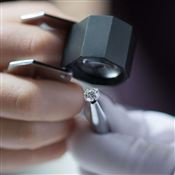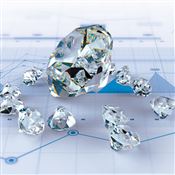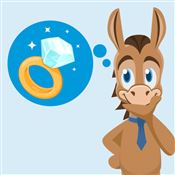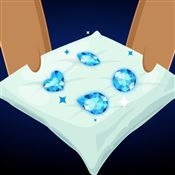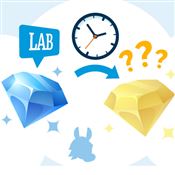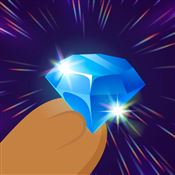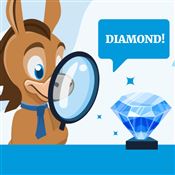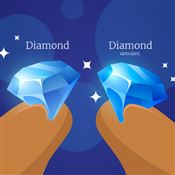Diamond Clarity
Don't overspend on clarity. Read this chart. Learn how to save money on clarity so you can get a bigger and more sparkly diamond. She will thank you.
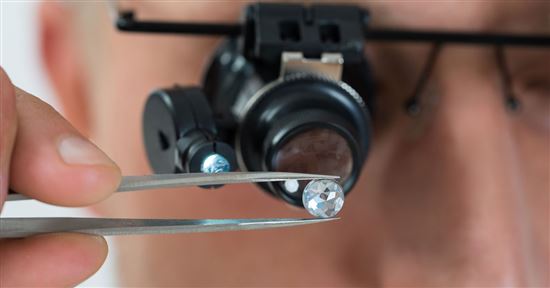 |
Clarity: Diamond Shopper's Biggest Mistake
Of the 4C's, clarity is the most misunderstood factor.
People often assume:
- You need a high clarity level to not see any flaws
- Higher clarity means a more sparkly diamond
This may lead people to unnecessarily overspend. But in fact, clarity is the least important factor.
If you know what to look for, you can save a ton of money and still get a visually flawless diamond. Use that money instead on a bigger rock or nicer setting. Who wouldn't want that?
Read on to learn all about diamond clarity.
Why Clarity is Not as Important
Don't pay for invisible features. In our opinion, clarity is the least visible factor. A flawless rock looks virtually the same as a lesser stone that is eye-clean.
- FL: Flawless - only about 1% of diamonds fall into this category.
- IF: Internally Flawless - tiny surface blemishes that are visible under 10x magnification.
- VVS1 VVS2: Very Very Slightly Included - tiny internal flaws that can only be seen by experts after intense searching under 10x magnification.
- VS1 VS2: Very Slightly Included - flaws usually not visible to naked eye.
- SI1 SI2: Slightly Included - flaws may be visible to naked eye.
- I1: Included 1st Degree - flaws visible even to the casual observer.
As long as the stone is eye-clean, it will look perfectly flawless. Eye-clean means that you cannot see the flaws with the naked eye.
Clarity is graded under 10x magnification. But in real life, no one is going to go around examining your diamond with jeweler's tools.
In most cases, VS2 diamonds are eye-clean. And you can even find eye-clean diamonds in the SI range (in fact, it's not even impossible at the I1 grade). So there's no need to pay extra for a flawless rock. You'll only be paying for features you can't even see.
Remember, an eye-clean diamond will look identical to a flawless diamond and cost much less. It's better to focus on cut (the most important of the 4C's) over clarity.
Search for VS2 Diamonds
Diamond Clarity Chart
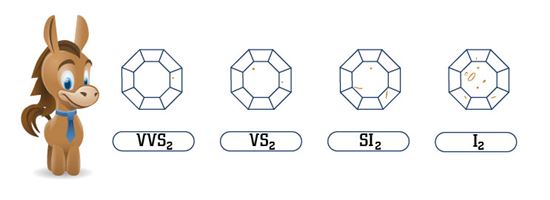 |
| Diamond Clarity Scale © CreditDonkey |
Clarity refers to the flaws on a diamond. There are two types: 1) inclusions, or internal flaws, and 2) blemishes, or flaws on the surface.
To determine clarity, the Federal Trade Institute requires that a diamond be examined under 10x loupe. The clarity grade depends on what kind of flaws can be seen under the 10x loupe.
The GIA grading scale for clarity is as follows (from best to worst):
- FL (Flawless):
Absolutely no flaws whatsoever under 10x magnification. This is super rare, only about 1% of all diamonds. - IF (Internally Flawless):
No visible internal flaws under magnification, but may have tiny surface blemishes, such as polishing lines. - VVSI & VVS2 (Very Very Slightly Included):
Almost perfect diamonds; very very small flaws that are difficult to see even under 10x magnification. In most cases, the most a trained professional can see is just tiny pinpoints.The difference between VVS1 and VVS2 is the location of flaws. VVS1 will have flaws in the bottom half, while VVS2's flaws may be in the top half as well.
- VS1 & VS2 (Very Slightly Included):
Slightly larger internal flaws or multiple smaller ones. More visible under magnification, but usually not to the naked eye.VS1 diamonds are always eye-clean. VS2 diamonds are usually eye-clean as well. But some diamonds may contain more noticeable flaws, especially if the diamond is larger.
The difference between VS2 and VS1 is in the size, location, and types of flaws. VS2 may have bigger flaws located more toward the top or center. It may also have black carbon crystals (which are usually not seen in VS1).
- SI1 & S12 (Slightly Included):
Inclusions are pretty easily seen under magnification, and possibly visible to the naked eye.SI1 diamonds could still be eye-clean depending on where and the type of flaw. SI2 diamonds have flaws that are more likely to be seen by the casual admirer.
- I1 (Included 1st Degree):
Larger flaws visible to the naked eye and can affect the diamond's brilliance and durability. Any kind of flaws are possible at this grade. (There are I2 and 13 too but because of the poor quality, most stores don't even sell those.)
As you can see, flaws don't start to become very noticeable until the SI range. And keep in mind that clarity is graded under 10x magnification. Your actual eyes can't see that well.
How Clarity Affects Price
Clarity has a huge impact on price, because the more flawless the stone, the rarer it is.
Here's an example of how price changes as you go up and down in clarity. We're using the the benchmark of 1-carat, H color, and Ideal cut.
| Carat | Color | Clarity | Cut | Price* |
|---|---|---|---|---|
| 1.0 | H | I1 | Ideal | $3,000 |
| 1.0 | H | SI2 | Ideal | $3,500 |
| 1.0 | H | SI1 | Ideal | $4,500 |
| 1.0 | H | VS2 | Ideal | $5,300 |
| 1.0 | H | VS1 | Ideal | $6,000 |
| 1.0 | H | VVS2 | Ideal | $6,500 |
| 1.0 | H | VVS1 | Ideal | $7,200 |
| 1.0 | H | IF | Ideal | $7,800 |
| *Pricing based on typical market price of online diamond retailers as of 2023. | ||||
As you can see, the difference between a Flawless diamond and VS2 diamond can be literaly thousands of dollars.
But as long as you get an eye-clean stone, a VS2 or SI1 diamond will look flawless. So don't spend the extra money on a feature that makes no visible difference. Put it instead towards an excellent cut and a bigger rock (which will be noticeable!).
Types of Flaws
Now let's first go over the common types of flaws you're likely to see.
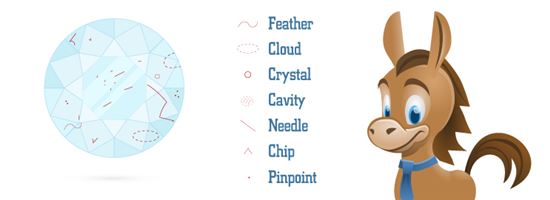 |
| Diamond Clarity © CreditDonkey |
- Crystals: These are minerals spots in the diamond. The two most common ones are white crystals (the best because they blend in) or black carbon spots (which if larger, would look like a speck of dust you can't rub off).
- Pinpoints: Very, very tiny crystals that just look like a dot at 10x. These cannot be seen and are no problem at all.
- Clouds: This is a cluster of pinpoints that may look like one larger flaw. If it's too big or dense, this may be visible or make a diamond appear a bit hazy.
- Needle: A long and thin crystal (like a rod) and is usually white in color.
- Feathers: Internal cracks. Watch out for where the feather is located. If it's near the edge, this may make the diamond susceptible to chipping.
- Graining: Caused by natural abnormal growth of the diamond's crystal structure. Graining could look like lines or a reflective white area, and can make a diamond appear hazy. It can either be internal or on the surface.
- Twining wisp: Flaws caused by irregular growth of the diamond's crystal structure. This is usually a group of clouds, pinpoints, feathers, and crystals.
- Cavity: A small hole/void in the diamond. Usually, this happens when a crystal at the surface falls out during polishing.
- Chip: A surface blemish usually either caused during the cutting process or during wear and tear. Diamonds are the hardest thing on Earth, but it can still chip given a sharp blow in the right direction.
- Polishing lines: Tiny lines on the surface made during polishing
- Scratch: An abrasion on the surface.
- Bearding: Very small fractures/feathers on the girdle (the edge of the diamond between the top and bottom halves). This happens when there was too much pressured applied when making the girdle and the edge becomes rough.
- Indented natural: A tiny part of the original rough diamond's surface that is recessed into the polished stone.
About 99% of the world's diamonds contain some sort of flaw. Of course, some flaws are better than others, such as small pinpoints or a white crystal. The type of flaws determines the diamond's clarity grade.
What to Look For
Not all flaws are created equal. The clarity grade is usually assigned based on the size of the inclusion, and not the color or location.
Some flaws are white or transparent, and some are black. Some are hidden towards the edge, and some are smack in the center. The flaw can even be in a spot where it gets reflected by the pavilion facets many times over.
The clarity grade doesn't tell you how the flaw looks on the diamond. Two SI2 diamonds could look completely different. One could be eye-clean, while the other has very visible flaws.
So what should you look for to get the best-looking diamond? Here are some tips:
- Look for inclusions along the edge.
The worst locations for flaws are right under the surface. Inclusions more towards the edges are less noticeable and can be hidden with prongs. Inclusions in the pavilion (the bottom part) can be hidden in a bezel setting. - Look for white colored inclusions.
White-colored inclusions (such as white crystals or feathers) blend in and can't really be seen. Clouds that are well scattered also look less visible. The worst ones are dark crystals right under the surface, which will look like dust specks that you just can't rub off.
Unfortunately, if you're buying a diamond less than VS2, you cannot be sure that the diamond will be eye-clean. Without a photo, there is no way to tell based on the grading report alone what kind of flaws the diamond contains.
The same clarity grade can look wildly different. So customers may feel like they have no choice but to purchase a diamond higher in clarity. It's best that you're able to examine the stone in person, or at least view high-def magnified photos.
Reading a Clarity Plot
A clarity plot is a diagram that shows the location and type of every flaw or blemish in the diamond. No two diamonds are alike, so this plot acts like "fingerprints" for your diamond. Usually, the GIA report will include a clarity plot for diamonds 1 carat or over.
Here's an example of what you might see:
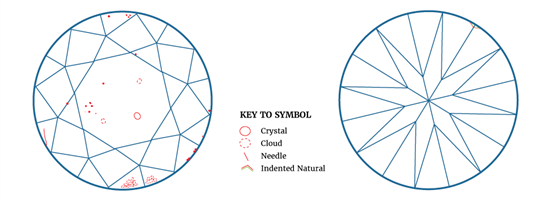 |
You can use it to get an idea of what kind of flaws the diamond has. But it doesn't show the whole picture.
In the example above, most of the flaws are on the top half of the diamond. There is a crystal almost in the center right under the table surface. But the plot won't tell you if the crystal is a transparent white one or a black one.
Without a real photo of the diamond, you won't know if it's a good buy or not.
If you're buying a diamond online, the clarity plot can be referenced but keep in mind that it won't tell you the whole story.
Some basic rules to shop by
Finally, here are some last rules-of-thumb to go by when purchasing a diamond:
- Cut is the most important. A perfectly cut diamond will exhibit a lot of brilliance to the point that it masks inclusions. Never skimp on cut! With a high-quality cut, you can get away with a diamond lower in color and clarity.
- VS2 diamonds are the sweet spot for getting a good quality diamond and saving money. It's usually a safe bet that the diamond will be eye-clean. If you're on a more limited budget, SI1-SI2 diamonds offer even better value. But you'll have to examine the diamond to make sure you can't see flaws.
- Go higher in clarity with step cut diamonds. Round diamonds are the priciest, but they also do a fantastic job of hiding imperfections (with an ideal cut). However, step cuts (such as emerald and asscher) have a large table straight into the depth of the diamond. Thus, flaws are more easily seen. We recommend no less than VS2, or VS1 for diamonds larger than a carat.
- Size matters too. Want a bigger rock? You'll probably have to pony up for a higher clarity too. Larger rocks (2 carat and over) will show more flaws as the facet sizes are larger. So we recommend that you go for a clarity grade VS1 or above in those cases.
- Stay away from Included Diamonds (I1 - I3), as they have large inclusions that affect the diamond's brilliance. And plus, durability becomes at stake too, as diamonds with large flaws are more easily chipped.
- Make sure the diamond is certified by GIA or AGS. These are the two most reputable labs with the highest grading standards. So you can trust that the diamond has been graded properly. Another lab may grade the diamond as VS1 and even be priced less expensively. But in reality, the diamond could be graded as VS2 or SI1 by GIA. So you don't want to pay for something that only looks good on paper.
Bottom Line
It is really not necessary to spend extra money to buy a diamond high in clarity. As long as the diamond is eye-clean, the diamond will look flawless.
Of course, if you have the budget and are after perfection, then go for that Flawless of VVS stone. But if your main concern is best value, then you can find diamonds that look just as visually flawless in the VS2 and SI ranges. Save the money and put it towards a better cut, better color, or large rock.
Search for Diamonds
Shop for diamonds at Whiteflash, a CreditDonkey recommended partner for super ideal cut diamonds.
Write to Anna G at feedback@creditdonkey.com. Follow us on Twitter and Facebook for our latest posts.
Note: This website is made possible through financial relationships with some of the products and services mentioned on this site. We may receive compensation if you shop through links in our content. You do not have to use our links, but you help support CreditDonkey if you do.
|
|
|



